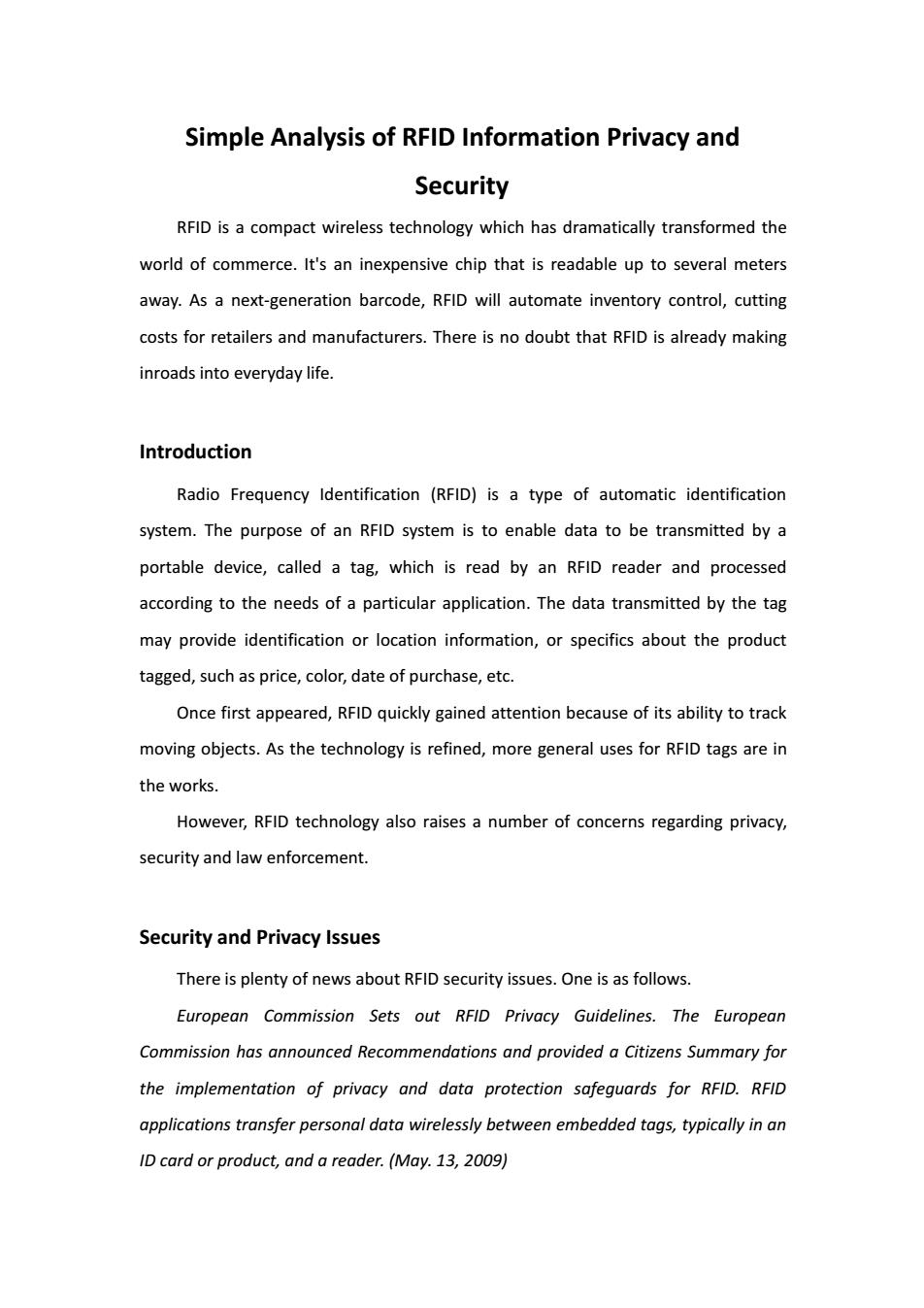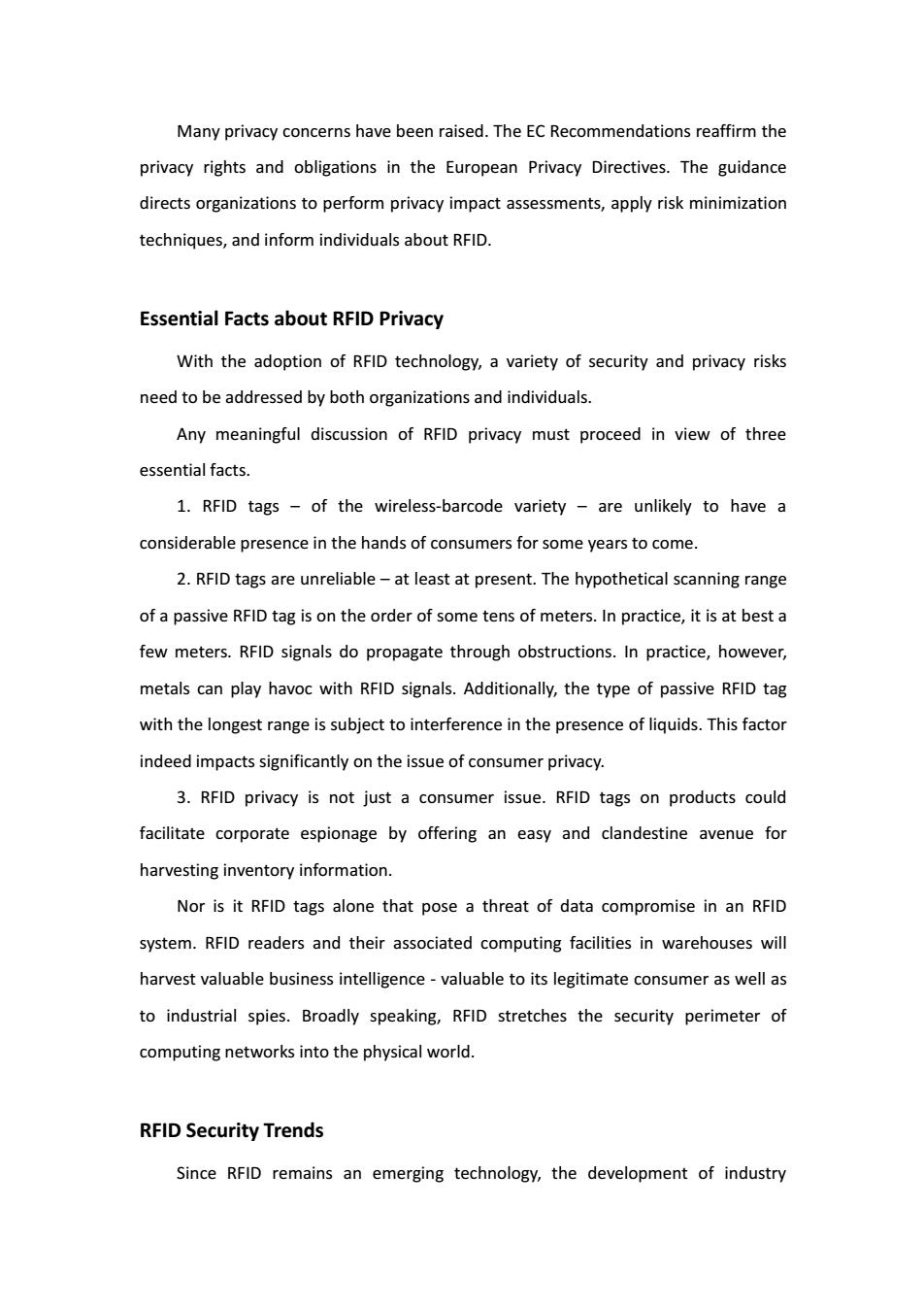
上游充通大粤 SHANGHAI JIAO TONG UNIVERSITY 供应链设计与管理 Designing and Waraging the Supply Chain Name:庞名章 No. 5090309594 First Report Title: Wal-Mart Report-Tips on Global Logistics and Risk Management Grade: Second Report Title: Simple Analysis of RFID Information Privacy and Security Grade:
供应链设计与管理 Designing and Managing the Supply Chain Name: 庞名章 No. : 5090309594 First Report Title: Wal-Mart Report-Tips on Global Logistics and Risk Management Grade: Second Report Title: Simple Analysis of RFID Information Privacy and Security Grade:

Simple Analysis of RFID Information Privacy and Security RFID is a compact wireless technology which has dramatically transformed the world of commerce.It's an inexpensive chip that is readable up to several meters away.As a next-generation barcode,RFID will automate inventory control,cutting costs for retailers and manufacturers.There is no doubt that RFID is already making inroads into everyday life. Introduction Radio Frequency Identification (RFID)is a type of automatic identification system.The purpose of an RFID system is to enable data to be transmitted by a portable device,called a tag,which is read by an RFID reader and processed according to the needs of a particular application.The data transmitted by the tag may provide identification or location information,or specifics about the product tagged,such as price,color,date of purchase,etc. Once first appeared,RFID quickly gained attention because of its ability to track moving objects.As the technology is refined,more general uses for RFID tags are in the works. However,RFID technology also raises a number of concerns regarding privacy, security and law enforcement. Security and Privacy Issues There is plenty of news about RFID security issues.One is as follows. European Commission Sets out RFID Privacy Guidelines.The European Commission has announced Recommendations and provided a Citizens Summary for the implementation of privacy and data protection safeguards for RFID.RFID applications transfer personal data wirelessly between embedded tags,typically in an ID card or product,and a reader.(May.13,2009)
Simple Analysis of RFID Information Privacy and Security RFID is a compact wireless technology which has dramatically transformed the world of commerce. It's an inexpensive chip that is readable up to several meters away. As a next-generation barcode, RFID will automate inventory control, cutting costs for retailers and manufacturers. There is no doubt that RFID is already making inroads into everyday life. Introduction Radio Frequency Identification (RFID) is a type of automatic identification system. The purpose of an RFID system is to enable data to be transmitted by a portable device, called a tag, which is read by an RFID reader and processed according to the needs of a particular application. The data transmitted by the tag may provide identification or location information, or specifics about the product tagged, such as price, color, date of purchase, etc. Once first appeared, RFID quickly gained attention because of its ability to track moving objects. As the technology is refined, more general uses for RFID tags are in the works. However, RFID technology also raises a number of concerns regarding privacy, security and law enforcement. Security and Privacy Issues There is plenty of news about RFID security issues. One is as follows. European Commission Sets out RFID Privacy Guidelines. The European Commission has announced Recommendations and provided a Citizens Summary for the implementation of privacy and data protection safeguards for RFID. RFID applications transfer personal data wirelessly between embedded tags, typically in an ID card or product, and a reader. (May. 13, 2009)

Many privacy concerns have been raised.The EC Recommendations reaffirm the privacy rights and obligations in the European Privacy Directives.The guidance directs organizations to perform privacy impact assessments,apply risk minimization techniques,and inform individuals about RFID. Essential Facts about RFID Privacy With the adoption of RFID technology,a variety of security and privacy risks need to be addressed by both organizations and individuals. Any meaningful discussion of RFID privacy must proceed in view of three essential facts. 1.RFID tags of the wireless-barcode variety are unlikely to have a considerable presence in the hands of consumers for some years to come. 2.RFID tags are unreliable-at least at present.The hypothetical scanning range of a passive RFID tag is on the order of some tens of meters.In practice,it is at best a few meters.RFID signals do propagate through obstructions.In practice,however, metals can play havoc with RFID signals.Additionally,the type of passive RFID tag with the longest range is subject to interference in the presence of liquids.This factor indeed impacts significantly on the issue of consumer privacy. 3.RFID privacy is not just a consumer issue.RFID tags on products could facilitate corporate espionage by offering an easy and clandestine avenue for harvesting inventory information. Nor is it RFID tags alone that pose a threat of data compromise in an RFID system.RFID readers and their associated computing facilities in warehouses will harvest valuable business intelligence-valuable to its legitimate consumer as well as to industrial spies.Broadly speaking,RFID stretches the security perimeter of computing networks into the physical world. RFID Security Trends Since RFID remains an emerging technology,the development of industry
Many privacy concerns have been raised. The EC Recommendations reaffirm the privacy rights and obligations in the European Privacy Directives. The guidance directs organizations to perform privacy impact assessments, apply risk minimization techniques, and inform individuals about RFID. Essential Facts about RFID Privacy With the adoption of RFID technology, a variety of security and privacy risks need to be addressed by both organizations and individuals. Any meaningful discussion of RFID privacy must proceed in view of three essential facts. 1. RFID tags – of the wireless-barcode variety – are unlikely to have a considerable presence in the hands of consumers for some years to come. 2. RFID tags are unreliable – at least at present. The hypothetical scanning range of a passive RFID tag is on the order of some tens of meters. In practice, it is at best a few meters. RFID signals do propagate through obstructions. In practice, however, metals can play havoc with RFID signals. Additionally, the type of passive RFID tag with the longest range is subject to interference in the presence of liquids. This factor indeed impacts significantly on the issue of consumer privacy. 3. RFID privacy is not just a consumer issue. RFID tags on products could facilitate corporate espionage by offering an easy and clandestine avenue for harvesting inventory information. Nor is it RFID tags alone that pose a threat of data compromise in an RFID system. RFID readers and their associated computing facilities in warehouses will harvest valuable business intelligence - valuable to its legitimate consumer as well as to industrial spies. Broadly speaking, RFID stretches the security perimeter of computing networks into the physical world. RFID Security Trends Since RFID remains an emerging technology, the development of industry

standards for protecting information stored on RFID chips is still being explored and strengthened.Research into the development and adaptation of efficient hardware for security codes and random number generators will improve RFID security.In addition,advances in RFID circuit design and manufacturing technology can also lower development costs releasing more resources in tags that can be used for other functions. Today,certain public key technologies are also being studied and in some cases deployed by RFID vendors.This helps improve confidentiality,user authentication and privacy of RFID tags and associated applications. What You Can Do to Protect Your Privacy There are a variety of solutions for tackling the security and privacy issues surrounding RFID.They can be categorized into the following areas. 1.Tag Data Protection One of solutions for tag data protection is password.Passwords can be used to protect tag data,preventing tags from being read without the owner's permission. But if the passwords for all the tags are identical,then the data becomes public. However,if each tag has a different or unique password,there may be millions of passwords that need to be recorded.So another solution,physical locking,has been come up.The tag manufacturer locks information such as a unique identifier into tag before the tag is released into an open environment.In other words,the chip is read-only and is embedded with information during the manufacturing process.This provides proof of origin.But this would result in higher memory cost and a larger size memory. 2.Reader Integrity When it comes to reader protection,readers can reject tag replies with anomalies in response times or signal power levels which don't match the physical properties of tags.If passive tags are used,this can be a way to prevent spoofing attempts.Readers can also use random frequencies with tags designed to follow a frequency dictated by
standards for protecting information stored on RFID chips is still being explored and strengthened. Research into the development and adaptation of efficient hardware for security codes and random number generators will improve RFID security. In addition, advances in RFID circuit design and manufacturing technology can also lower development costs releasing more resources in tags that can be used for other functions. Today, certain public key technologies are also being studied and in some cases deployed by RFID vendors. This helps improve confidentiality, user authentication and privacy of RFID tags and associated applications. What You Can Do to Protect Your Privacy There are a variety of solutions for tackling the security and privacy issues surrounding RFID. They can be categorized into the following areas. 1. Tag Data Protection One of solutions for tag data protection is password. Passwords can be used to protect tag data, preventing tags from being read without the owner’s permission. But if the passwords for all the tags are identical, then the data becomes public. However, if each tag has a different or unique password, there may be millions of passwords that need to be recorded. So another solution, physical locking, has been come up. The tag manufacturer locks information such as a unique identifier into tag before the tag is released into an open environment. In other words, the chip is read-only and is embedded with information during the manufacturing process. This provides proof of origin. But this would result in higher memory cost and a larger size memory. 2. Reader Integrity When it comes to reader protection, readers can reject tag replies with anomalies in response times or signal power levels which don’t match the physical properties of tags. If passive tags are used, this can be a way to prevent spoofing attempts. Readers can also use random frequencies with tags designed to follow a frequency dictated by

them.Moreover,Readers can change frequencies randomly so that unauthorized users cannot easily detect and eavesdrop on traffic.On the other hand,RFID environments can be equipped with special devices to detect unauthorized read attempts or transmissions on tag frequencies.These read detectors may be used to detect unauthorized read/update attempts on tags,if they are used together with specially designed tags that can transmit signals over reserved frequencies,indicating any attempts to kill or modify tags. While the use of RFID technology is increasing across a range of different industries,the associated security and privacy issues need to be carefully addressed. For its powerful function,RFID is fully believed to be competitive,and even be developed into a global Internet of Things.Therefore,its privacy and security issues cannot be ignored
them. Moreover, Readers can change frequencies randomly so that unauthorized users cannot easily detect and eavesdrop on traffic. On the other hand, RFID environments can be equipped with special devices to detect unauthorized read attempts or transmissions on tag frequencies. These read detectors may be used to detect unauthorized read/update attempts on tags, if they are used together with specially designed tags that can transmit signals over reserved frequencies, indicating any attempts to kill or modify tags. While the use of RFID technology is increasing across a range of different industries, the associated security and privacy issues need to be carefully addressed. For its powerful function, RFID is fully believed to be competitive, and even be developed into a global Internet of Things. Therefore, its privacy and security issues cannot be ignored